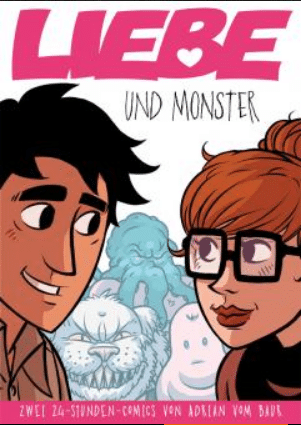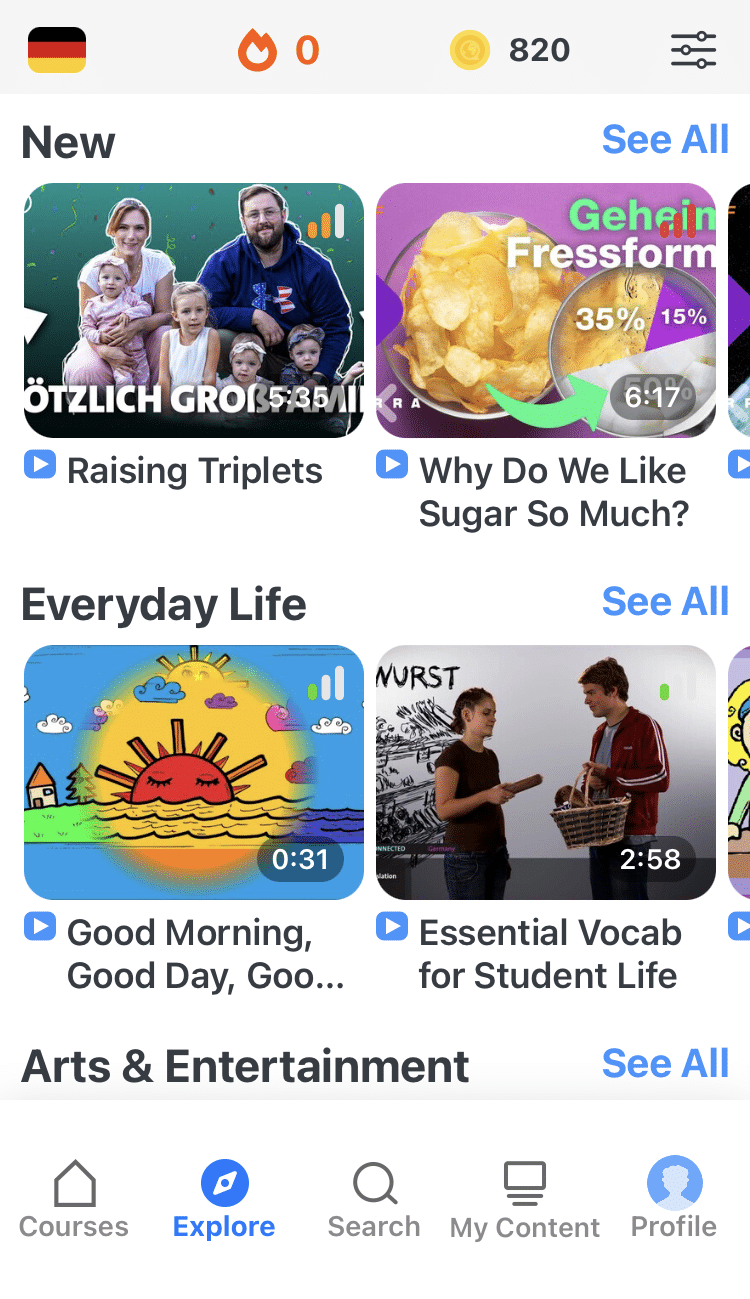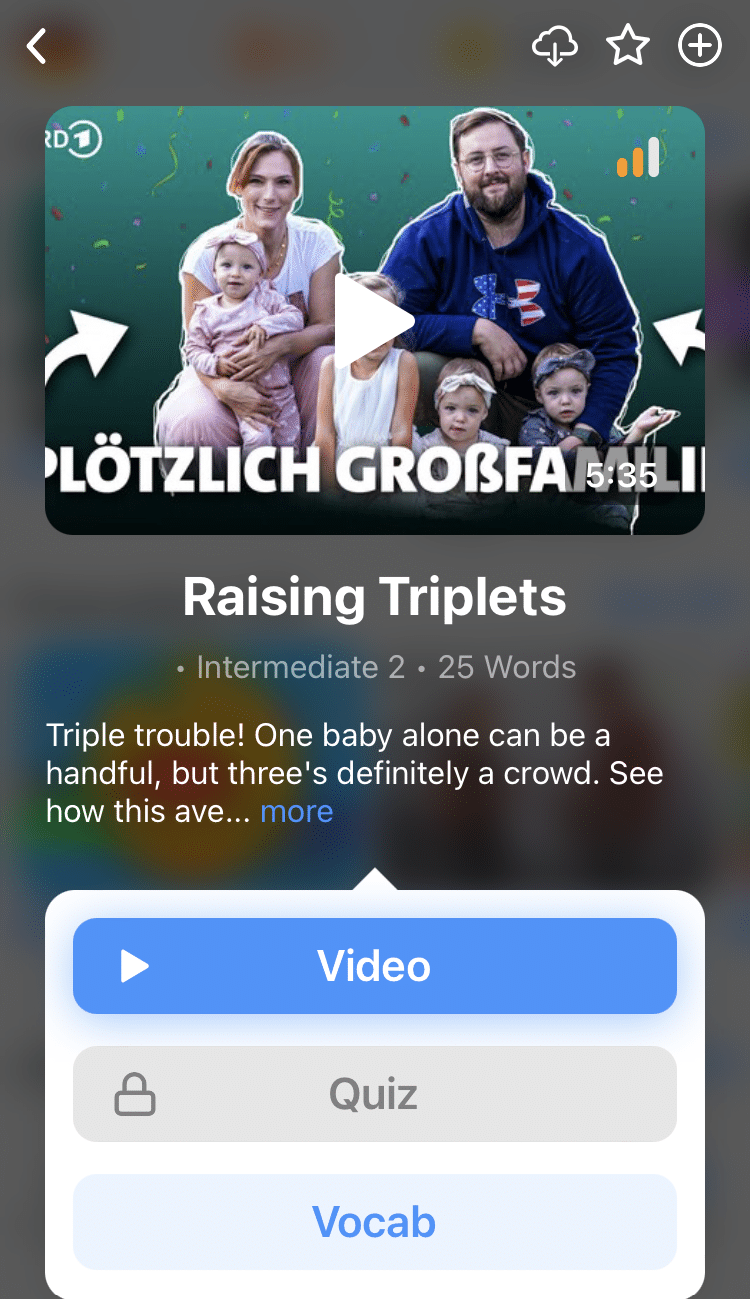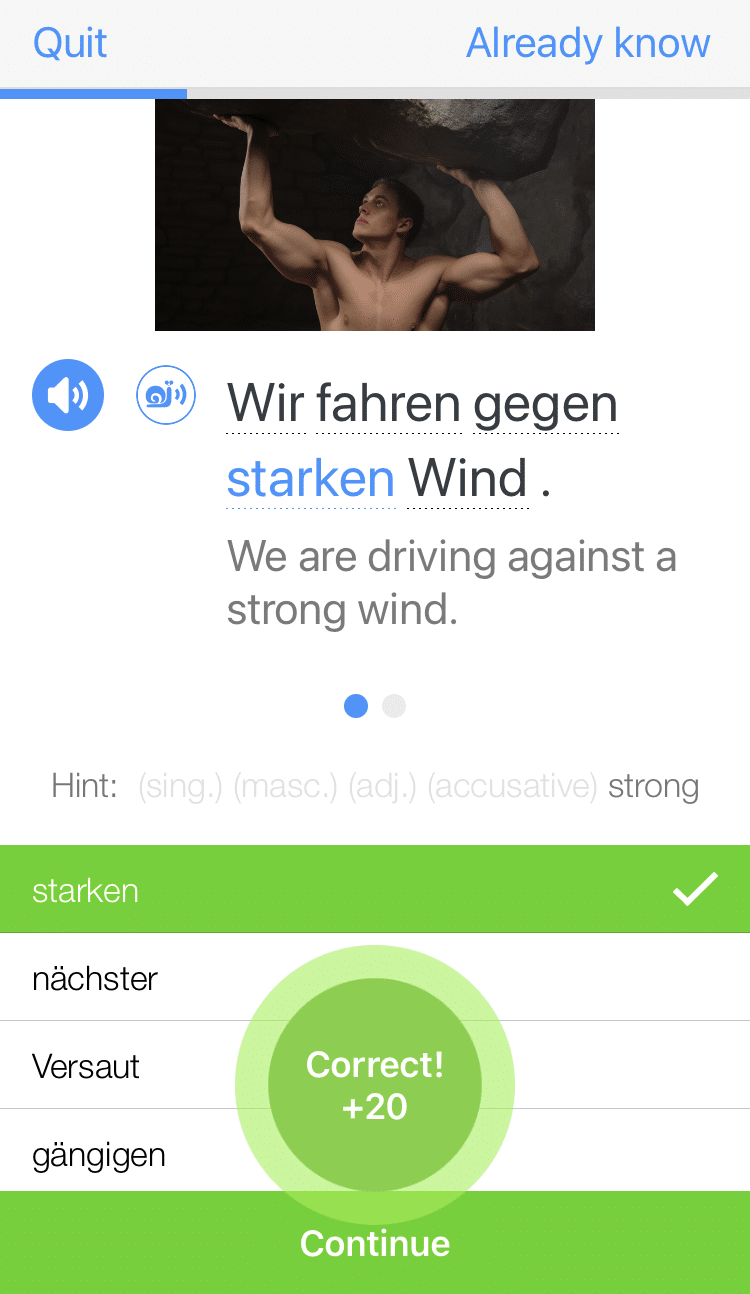
19 German Comics for Learners
Comic books and graphic novels aren’t just for kids.
There are actually a ton of really cool ones out there based on intriguing stories for adults.
And did you know that comics and graphic novels can help you learn German?
In this post, you’ll get 19 fantastic comic books that can strengthen your German language skills!
Contents
- 1. “Das Leben ist kein Ponyhof” (Life Ain’t No Pony Farm)
- 2. “Berlin”
- 3. “Der Traum von Olympia” (The Dream of Olympia)
- 4. “Heute ist der letzte Tag vom Rest deines Lebens” (Today is the last Day of the Rest of your Life)
- 5. “Liebe und Monster” (Love and Monsters)
- 6. “Business Worm”
- 7. “Ethel & Ernest”
- 8. “Die anderen Mendelssohns: Karl Mendelssohn Bartholdy” (The other Mendelssohns: Karl Mendelssohn Bartholdy)
- 9. “Kinderland” (Child Land)
- 10. “Die Wormworld Saga” (The Wormworld Saga)
- 11. “Die Stadt der Träumenden Bücher” (The City of Dreaming Books)
- 12. “Persepolis”
- 13. “Faust: Der Tragödie erster Teil” (Faust: The Tragedy Part One)
- 14. “Werners Beinhaatcover” (Werner’s Leg Hair Cover)
- 15. “Fix und Foxi” (Fix and Foxi)
- 16. “Tim Und Struppi” (The Adventures of Tintin)
- 17. “Lustiges Taschenbuch” (Donald Duck Pocketbook)
- 18. “Von Spatz”
- 19. The “Asterix” Series
- Why Read German Language Comic Books?
- How to Improve Your German With Comic Books
- And One More Thing...
Download: This blog post is available as a convenient and portable PDF that you can take anywhere. Click here to get a copy. (Download)
1. “Das Leben ist kein Ponyhof” (Life Ain’t No Pony Farm)
The name for Sarah Burrini’s comic comes from a German idiom, which means something like “life isn’t all a bed of roses,” but literally translates to “life ain’t no pony farm.”
A weekly comic is published on Sarah’s homepage. Most of the comics come from her very own pen, but she does often showcase works from guest comics and illustrators.
2. “Berlin”
One of the many English language comic books to be translated into German, “Berlin” was created by Jason Lutes.
Focusing on the German capitol during the 1920s, “Berlin” follows art student Marthe Müller throughout her stay in the titular city.
German history aficionados may already have an inkling of where this book is heading. Regardless, I recommend you give this a read, as Lutes’ writing is simply compelling.
3. “Der Traum von Olympia” (The Dream of Olympia)
One of Reinhard Kleist’s best-loved comic books, “Der Traum von Olympia” tells the story of Samia Yusuf Omar, a sprinter who represented Somalia in the 2008 Peking Olympics.
If you’re wondering why a German comic book author wrote about a Somalian athlete who competed in an international athletics competition in China (granted, this is the Olympics, but still), let me direct you to this article from The Guardian which detailed what she went through up until her tragic death in 2012.
4. “Heute ist der letzte Tag vom Rest deines Lebens” (Today is the last Day of the Rest of your Life)
Ulli Lust is possibly one of the most popular German language comic illustrators. She regularly publishes mini-comics online, but also has a fantastic selection of graphic novels to choose from.
“Heute ist der letzte Tag vom Rest deines Lebens” is arguably her most popular. This autobiographical comic is based on the summer of 1984, in which she went backpacking around Italy with her friend. She portrays the interesting characters she meets in a way that would make for a great Netflix show.
5. “Liebe und Monster” (Love and Monsters)
Adrian von Bauer’s intriguing comic book is about a first date between Kieran and Tasmin. After a slightly awkward start, things get exciting after a portal into a new dimension opens and throws them into an adventure.
As you can imagine, they get to know each other better along the way. Will they get closer and fall even deeper in love? Only one way to find out!
“Liebe und Monster” has been translated into English, so should you get stuck on the German, you can always pick up an English copy to help you out.
6. “Business Worm”
Tim Gaedke used to have a website with a great selection of quirky web comic strips. These days, he mostly does artwork for playmats, mousepads, gaming bags, keyboards and the like.
However, you can still find traces of his comics around the web, like “Business Worm.” As you can guess from the title and the book cover, it’s about a world where worms and other not-so-creepy-crawlies try to get through the grind of their day-to-day existence.
If you’re looking to get some relatable tidbits of what work life is like, you’ll want to get a hold of this one.
7. “Ethel & Ernest”
The English illustrator Raymond Briggs’ heartwarming comic book now has a German translation.
In the comic, Briggs tells the story of his parents, Ethel and Ernest, from their meeting all the way through their lives up until their deaths.
If you need convincing that this book is worth a try, you may want to check out the film version first. Make sure you ready your tissue box, because some scenes will bring out the waterworks.
8. “Die anderen Mendelssohns: Karl Mendelssohn Bartholdy” (The other Mendelssohns: Karl Mendelssohn Bartholdy)
Chances are you’ll have heard of Felix Mendelssohn, the world-renowned classical composer. Well, now it’s time to find out about his two sons, Karl and Paul.
In this edition of Elke Rentate Steiner’s comic book, Karl’s life story is retold in flashbacks by his younger brother, Paul.
Whether you have a sibling or know people who have one (or two, or three), you’ll probably see yourself in these two brothers.
9. “Kinderland” (Child Land)
Created by the illustrator Mawil, “Kinderland” is set in the GDR (German Democratic Republic) and former East Germany. This autobiographical graphic novel is set in 1989 and looks at life under Communist rule through the eyes of a child.
Like some of the selections we’featured so far, “Kinderland” has an English version that you can check out if your German is still a bit shaky. But if you really want to immerse yourself in the language, I suggest you get into the original version first. You can also use bilingual texts if those are more to your liking.
10. “Die Wormworld Saga” (The Wormworld Saga)
Do you enjoy fantasy series in which characters literally get transported into another world? Are you a Studio Ghibli fan? If your answer to both questions is a resounding “Yes,” “Die Wormworld Saga” might just be right up your alley.
This series of graphic novels revolves around a young boy named Jonas, who stumbles across a magical portal and is whisked away into an alternate reality where he journeys across towering mountains, dark forests and endless deserts.
Apparently, the series’ author-slash-illustrator Daniel Lieske was inspired by films like “Princess Mononoke” and “Spirited Away,” so don’t be surprised if the Wormworld Saga feels like something Hayao Miyazaki would’ve come up with.
Oh, and if you prefer reading on a screen, you can also read all of the graphic novels for free here.
11. “Die Stadt der Träumenden Bücher” (The City of Dreaming Books)
Based on the 2004 novel by Walter Moers, “Die Stadt der Träumenden Bücher” takes you into a fantasy world where bücher (books) keep economies afloat and there’s an honest-to-goodness profession where people fight over books because they’re just that valuable in this alternate reality. (I wish print books are just as valuable in the digital age, but I digress.)
The main character, Hildegunst von Mythenmetz (one of the most awesome fictional names, in my opinion), is an aspiring poet who wants to uncover the secrets behind a mysterious text his dying poet godfather gives him. Thus, he sets off to the city of Buchhaim, the titular city of “dreaming books,” and has to fight enemies including someone who—gasp!—dislikes good literature.
12. “Persepolis”
The title refers to the capital of the ancient Achaemenid (a.k.a. Persian) Empire, which has since been designated as a UNESCO World Heritage Site. However, the plot takes place in a time that’s much closer to ours.
“Persepolis” is based on the real-life experiences of its author Marjane Satrapi, who grew up in Iran (formerly Persia) during the Islamic Revolution in the late 1970s. The contents of the book were so disturbing that it ended up on the American Library Association’s “Top 10 Most Challenged Books of 2014.”
Also, parts of the book take place in Austria, one of the countries the author stayed in, so if you’re interested in the German dialect from that region, pick up a copy of this one.
13. “Faust: Der Tragödie erster Teil” (Faust: The Tragedy Part One)
You’re probably familiar with the story of Faust, a semi-mythical, semi-historical figure who supposedly made a deal with the Devil to grant him unimaginable knowledge, wealth and fortune in exchange for his soul.
This comic book by the artist Flix gives that timeless tale a modern twist. In this version, Faust is a cab driver in Berlin who does the same thing as his medieval counterpart. If you enjoyed this book, you can also check out the artist’s other German works on his website.
14. “Werners Beinhaatcover” (Werner’s Leg Hair Cover)
From that double-take-worthy title alone, you can already guess that this comic is going to tickle your funny bone from beginning to end—if you can decipher the Northern German dialect throughout, that is.
Unfortunately (or fortunately, depending on where you are in your German studies), there’s hardly any Standard High German (SHG) here outside of formal contexts. But if you’re interested in the other German dialects and loads (and loads!) of puns, have a go at this one.
15. “Fix und Foxi” (Fix and Foxi)
On the other side of the German difficulty spectrum is “Fix und Foxi,” a comic series about the titular twin fox brothers. These characters were popular enough in Germany to have their own TV show, which kicked off in 2000.
Because this series is aimed at young readers, it’s a great way to get into German comics and beginner German at the same time. The artwork is also reminiscent of Disney’s style, so if Mickey Mouse and his posse were a huge part of your childhood, Rolf Kauka’s work will take you back to Nostalgia Land.
16. “Tim Und Struppi” (The Adventures of Tintin)
In case you’re not familiar with it, “Tim Und Struppi” (literally “Tim and Snowy,” the latter referring to the main character’s pet dog) is about a young Belgian man named Tintin, an investigative journalist who often gets entangled in dangerous situations where he has to use all of his wits and resourcefulness to save the day.
It’s a well-worn trope (the ordinary guy who proves his not-so-ordinary mettle through extraordinary situations), but it’s done really well here. There’s a reason this one is considered a classic and has spawned a ton of adaptations including a 2011 Steven Spielberg film.
17. “Lustiges Taschenbuch” (Donald Duck Pocketbook)
I’m not sure why the German title for the Donald Duck pocketbooks is as on-the-nose as “funny pocketbook,” but that’s what we have here. If you don’t mind the mental image of Donald Duck talking in German in his distinctive quacky voice, you can easily get through this one.
Given that it’s aimed at a younger audience, you can expect that you won’t be flipping through your dictionary (much) as you read this one. If nothing else, the accompanying images can always give you context clues as to what the characters are saying.
18. “Von Spatz”
Speaking of Disney, “Von Spatz” opens with the Donald Duck creator himself having a breakdown and being forced into the titular rehabilitation center. If that feels like such a rapid escalation from Disney’s more lighthearted works, I apologize—but I promise that this gets better!
Anyone who’s an artist in any capacity can relate to this book by Anna Haifisch. Haifisch weaves together an insightful, darkly funny work about the artist’s struggle. Here’s a review published on World Literature Today that sums up nicely what “Von Spatz” is all about.
19. The “Asterix” Series
If you’re a native German speaker, comic book lover and historical fantasy fiction enthusiast, chances are you’ve heard of the “Asterix” series. It’s set during the time of the Roman Empire and revolves around a village of Gauls, a group that the titular main character belongs to.
Historical inaccuracies aside (for example, the Gauls never wore Asterix’s distinctive winged helmet), this is a fun read. It’s also brimming with wordplay and puns, making this a great resource for anyone getting their feet wet in German.
Why Read German Language Comic Books?
With comics, getting your German reading practice is a whole lot easier than slogging through a whole novel. The text mostly includes dialogue, and the drawings help you follow the story through context clues. That means you don’t have to worry about getting stuck in endless paragraphs of descriptions.
So if you’re a beginner in German or someone who isn’t really into reading in the first place, comics are a good starting point to help build your way up to the big novels.
Another plus of comic books is that they’re often translated from other languages like English. So if anything you read stumps you, you can always refer back to the version of the comic in your native language.
How to Improve Your German With Comic Books
One way to make the most of your comics is to use them to create a German vocab list. Every language learner needs a vocab list, no matter their level. If you have all your weak words—or words you don’t know—together in one place, you’ll be able to work on them all at once.
When you’re reading your comic and come across a word you need to look up, simply add it to your list! Keep returning to the list to test yourself, and eventually, you’ll build up your bank of vocabulary.
Besides vocabulary building, comics are also surprisingly effective tools for speaking practice. Get some friends over, divide the comic characters between you, and have a go at acting out the scenes. You don’t have to go to the trouble of getting too theatrical about it—just hang out on the couch and read the lines to each other, helping each other with pronunciation as you go.
Feeling inspired by all the German comic books you’ve been reading? How about getting creative and making your own? Just like reading comics with friends doesn’t have to be too elaborate, this doesn’t have to be too artistic—just a few doodles should do. Most importantly, this will allow you to practice your German as you flex your writing muscles.
I hope my list has motivated you to fill your bookshelf and coffee table with German comic books!
There are absolutely loads to choose from and, as mentioned previously, many English language ones are often translated, creating such a great range of stories.
Download: This blog post is available as a convenient and portable PDF that you can take anywhere. Click here to get a copy. (Download)
And One More Thing...
Want to know the key to learning German effectively?
It's using the right content and tools, like FluentU has to offer! Browse hundreds of videos, take endless quizzes and master the German language faster than you've ever imagine!
Watching a fun video, but having trouble understanding it? FluentU brings native videos within reach with interactive subtitles.
You can tap on any word to look it up instantly. Every definition has examples that have been written to help you understand how the word is used. If you see an interesting word you don't know, you can add it to a vocabulary list.
And FluentU isn't just for watching videos. It's a complete platform for learning. It's designed to effectively teach you all the vocabulary from any video. Swipe left or right to see more examples of the word you're on.
The best part is that FluentU keeps track of the vocabulary that you're learning, and gives you extra practice with difficult words. It'll even remind you when it’s time to review what you’ve learned.
Start using the FluentU website on your computer or tablet or, better yet, download the FluentU app from the iTunes or Google Play store. Click here to take advantage of our current sale! (Expires at the end of this month.)

























